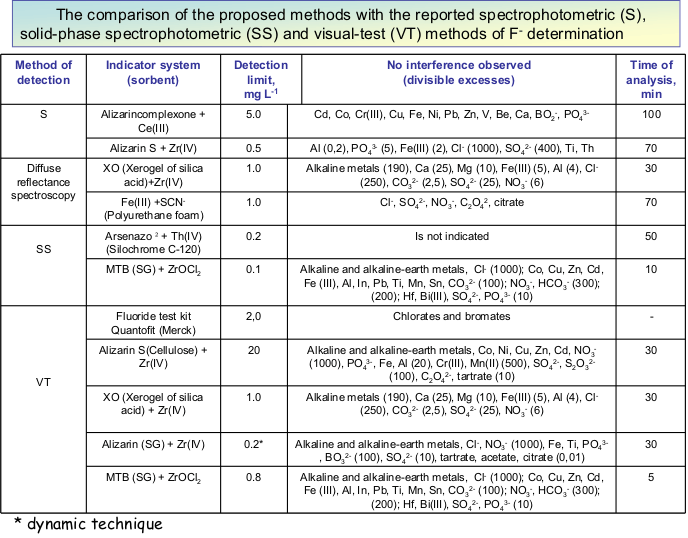
CONCLUSIONS:
• The method proposed for fluoride determination is inferior in sensitivity to the
known ion-selective electrodes-based methods (DL=0.019 mg/L). At the same time it is proved
to be more selective, especially regarding Al(III), Fe(III), Mg(II) and Са(ІІ).
The influence of ionic strength of solution revealed to be noticeably lower
making possible the application of the method to fluoride determination in highly
mineralized media.
• As the reaction product is concentrated, the sensitivity of the method
is 2,5 and 25-fold higher in comparison with photometric methods based on the
decoloration of alizarin complexes with Zr(IV) and Се(ІІІ), respectively. Due to the
equilibrium reached in only 2 min the proposed indicator reaction allows to decrease
the time of one determination from 70-100 to 10 minutes. Moreover,
low reproducibility of the measurements possible in solution as a result of varnish
formation does not appear when the immobilized reagent is used. The developed method gains
in selectivity up to 5-times when compared to diffuse reflectance spectroscopic
method. Having the same detection limit it requires drastically less
time for the determination in comparison to SS method based on Th(IV) interaction with
arsenazo I.
• The visual test-method comes over the reported methods in sensitivity.
In comparison with the dynamic method of fluoride determination using competitive reaction
of Zr(IV) with alizarin proposed by the authors earlier, this one has a slightly higher
detection limit, being at the same time much more rapid (up to 6 times) and simple. This allows
using the developed solid-phase reagent as a ready-to-use analytical form, suitable for
the application out of laboratory (on-site).
• The developed sorption-spectroscopic and visual test methods are
simple, cost-effective and may be applied for the determination of
C2O42- in urine. No use of toxic compounds and
short time of the procedure (less than 10 min/a single determination) are the main
advantages of the proposed methods. The visual test-method of oxalate determination
in urine may be applied directly at the site of sampling and does not require expensive
equipment to be used.
